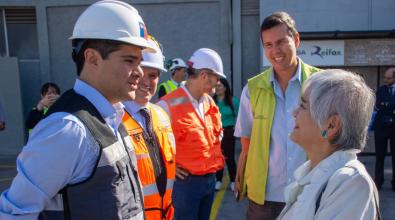 Read More
Read More
3 strategies for attracting next-generation tech talent to cities

Listen to This Article
Great ideas only have impact when they lead to services and solutions that improve people’s lives. The trend toward better product management in local government in recent years reflects this; it’s not about chasing tech, but about closing the gap between intention and implementation. Now, as artificial intelligence presents new opportunities and risks for cities, local leaders are fine-tuning strategies for building teams that can help them make the right tech choices and, ultimately, ensure digital tools deliver actual public value.
“Product managers are like translators between resident needs and this new technology, and that is the number one skill every city needs right now,” explains Carrie Bishop, who works on the Government Innovation team at Bloomberg Philanthropies and previously served as San Francisco’s first chief digital services officer.
Here are strategies cities everywhere can use to ensure they have the right tech-focused talent in place not just to tap into AI, but to do so with purpose.
Tell a better story about what tech in government means.
Over the past decade, cities have made tremendous progress in cultivating tech and digital talent, and upskilling programs are often a powerful way for them to keep their teams sharp, including in this AI moment. But when leaders do decide they need to hire new staff, it’s not enough to just post jobs widely; they also need to tell compelling stories. The best candidates are drawn to a sense of purpose, and, right now, to the possibilities that AI offers to improve tens of thousands or even millions of lives—fast.
“The thing cities are always going to win on is mission,” says Justin Elszasz, the former Baltimore chief data officer who is now part of the Bloomberg Philanthropies City Data Alliance and specifically works with cities on stretching their AI ambition.
For cities, this starts with language. Too many job descriptions still emphasize themes like modernization and digitization, which can feel flat to digital natives, and perhaps especially to those keen on raising ambition for what AI can deliver in this moment. And while civil-service rules may limit exactly how dramatically cities can overhaul job titles and descriptions, they are finding success when they reframe roles around creativity, impact, and user experience.
“It's super important to connect with people on the creativity of it all,” explains Krizia Lopez, a former Google staffer and Bloomberg Harvard City Hall fellow in St. Louis. “Sometimes in government, we're so focused on the rules and the exact specifications of the role, when, in fact, a lot of these digital and product-management roles that are going to be necessary for the AI revolution are creative ones.”
Likewise, she notes, tech talent is often interested in thinking about where they might be able to reach the most people with their work. And cities have a great story to tell them on that front, too.
“When you think about local government, your users are all the residents—that’s a built-in user base that’s massive,” says Lopez. “You can build tools that actually change lives.”
Make the hiring process a window, not a wall.
While local governments across the world are learning to hire much more quickly, the reality is they may never be able to match the pace of some tech companies. But what they can do is be transparent about their process, be coherent about their benefits, and show clearly what roles will look like in practice.
“Even if your process is going to take three months, if people know that from the start, it’ll make their experience better,” explains Krista Canellakis, digital delivery program director at U.S. Digital Response, a nonprofit that helps governments build up state capacity and offers a toolkit to help them bring on digital talent.
This need for greater clarity extends to compensation and benefits, which are often presented in a way that fails to capture exactly what the public sector can offer. For instance, governments sometimes still list extremely broad salary bands for product manager or UX designer roles because they fall within larger job classifications, and applicants may not take the time to make sense of it all. Making those classifications more specific is its own challenge, but in the meantime, cities can do a better job of explaining to candidates just how many baked-in raises and other benefits they will receive if they become public servants.
Another piece of this is getting agency leaders themselves involved in hiring—not just HR—so candidates have a clearer picture of what kind of tech environment they’re joining. “You’ve got to level with candidates about your systems,” Elszasz explains. “Some might see legacy software as a challenge. But for others, that’s the whole point. They want to fix it.”
Tap into networks to find talent fast.
In addition to making structural changes to fast-track new tech talent, it can help cities to realize that they are not alone in this pursuit. For example, Caitlin Lewis and the team at the nonprofit Work for America can quickly identify candidates that may suit their needs.
Last year, Work for America launched Civic Match, a nonpartisan initiative connecting mission-driven professionals with meaningful public-sector roles across the United States. And as of early this month, Lewis’ team had 400 people with skills directly related to local-government AI implementation ready to be matched with roles in their database. Among the new members of Lewis’ own team is Lopez, who is determined to bring her perspective on what cities need to take the next step on digital and AI to a wider audience of those seeking work in the public sector.
What connects these latest talent efforts from local leaders and their partners is a recognition that cities can’t outsource digital expertise if they’re going to use new technologies, whether AI or otherwise, to deliver what their residents need. As Beth Blauer, vice president for public impact initiatives at Johns Hopkins University puts it, “We need people who deeply understand the public challenges that we're trying to solve, and know how to speak enough of the language of AI to be able to scope product design.”

